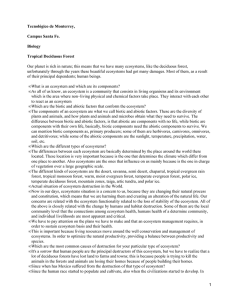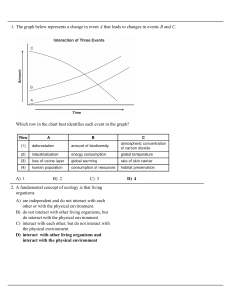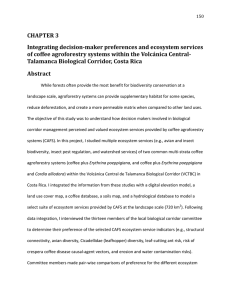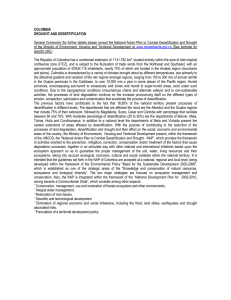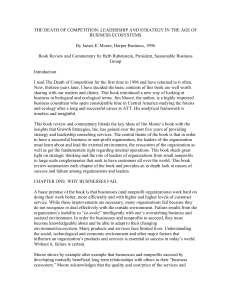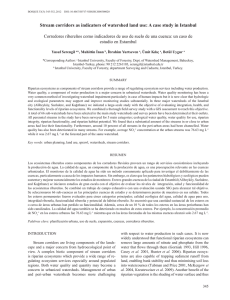The Concept of Organisms as Ecosystem Engineers Ten Years On
Anuncio
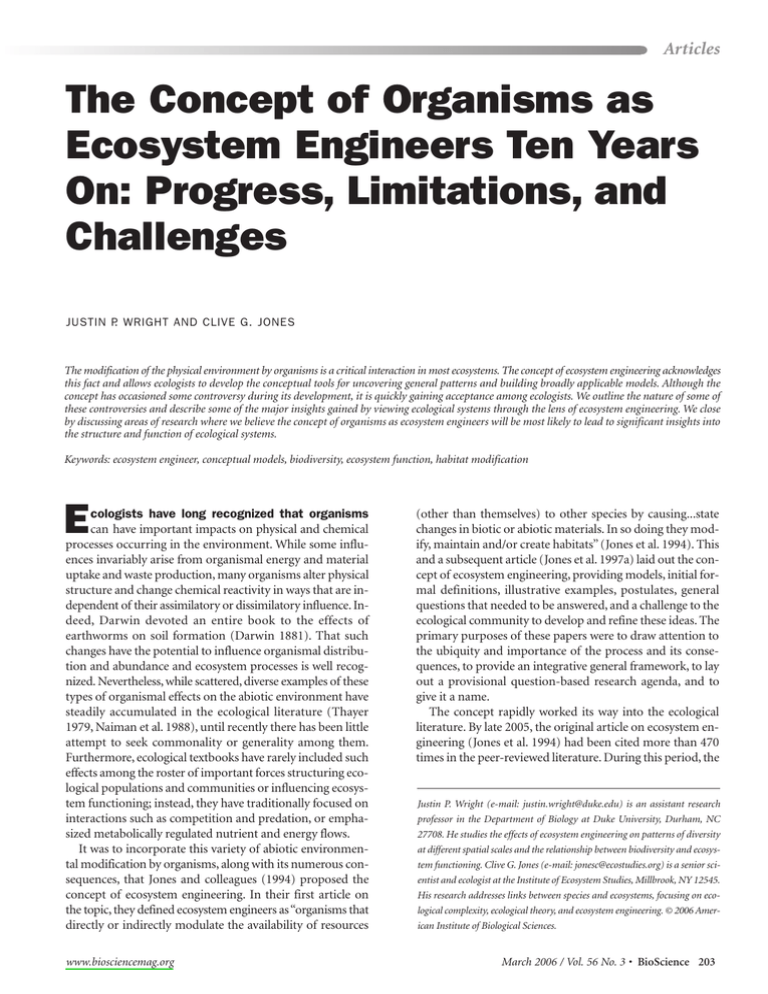
Articles The Concept of Organisms as Ecosystem Engineers Ten Years On: Progress, Limitations, and Challenges JUSTIN P. WRIGHT AND CLIVE G. JONES The modification of the physical environment by organisms is a critical interaction in most ecosystems. The concept of ecosystem engineering acknowledges this fact and allows ecologists to develop the conceptual tools for uncovering general patterns and building broadly applicable models. Although the concept has occasioned some controversy during its development, it is quickly gaining acceptance among ecologists. We outline the nature of some of these controversies and describe some of the major insights gained by viewing ecological systems through the lens of ecosystem engineering. We close by discussing areas of research where we believe the concept of organisms as ecosystem engineers will be most likely to lead to significant insights into the structure and function of ecological systems. Keywords: ecosystem engineer, conceptual models, biodiversity, ecosystem function, habitat modification E cologists have long recognized that organisms can have important impacts on physical and chemical processes occurring in the environment. While some influences invariably arise from organismal energy and material uptake and waste production, many organisms alter physical structure and change chemical reactivity in ways that are independent of their assimilatory or dissimilatory influence. Indeed, Darwin devoted an entire book to the effects of earthworms on soil formation (Darwin 1881). That such changes have the potential to influence organismal distribution and abundance and ecosystem processes is well recognized. Nevertheless, while scattered, diverse examples of these types of organismal effects on the abiotic environment have steadily accumulated in the ecological literature (Thayer 1979, Naiman et al. 1988), until recently there has been little attempt to seek commonality or generality among them. Furthermore, ecological textbooks have rarely included such effects among the roster of important forces structuring ecological populations and communities or influencing ecosystem functioning; instead, they have traditionally focused on interactions such as competition and predation, or emphasized metabolically regulated nutrient and energy flows. It was to incorporate this variety of abiotic environmental modification by organisms, along with its numerous consequences, that Jones and colleagues (1994) proposed the concept of ecosystem engineering. In their first article on the topic, they defined ecosystem engineers as “organisms that directly or indirectly modulate the availability of resources www.biosciencemag.org (other than themselves) to other species by causing...state changes in biotic or abiotic materials. In so doing they modify, maintain and/or create habitats” (Jones et al. 1994). This and a subsequent article (Jones et al. 1997a) laid out the concept of ecosystem engineering, providing models, initial formal definitions, illustrative examples, postulates, general questions that needed to be answered, and a challenge to the ecological community to develop and refine these ideas. The primary purposes of these papers were to draw attention to the ubiquity and importance of the process and its consequences, to provide an integrative general framework, to lay out a provisional question-based research agenda, and to give it a name. The concept rapidly worked its way into the ecological literature. By late 2005, the original article on ecosystem engineering (Jones et al. 1994) had been cited more than 470 times in the peer-reviewed literature. During this period, the Justin P. Wright (e-mail: [email protected]) is an assistant research professor in the Department of Biology at Duke University, Durham, NC 27708. He studies the effects of ecosystem engineering on patterns of diversity at different spatial scales and the relationship between biodiversity and ecosystem functioning. Clive G. Jones (e-mail: [email protected]) is a senior scientist and ecologist at the Institute of Ecosystem Studies, Millbrook, NY 12545. His research addresses links between species and ecosystems, focusing on ecological complexity, ecological theory, and ecosystem engineering. © 2006 American Institute of Biological Sciences. March 2006 / Vol. 56 No. 3 • BioScience 203 Articles concept also generated significant controversy; one decade from its inception, we thought it would be fruitful to examine the nature of these controversies, evaluate the success of the concept in stimulating novel ecological research, and speculate on its potential to generate future scientific advances. Ecosystem engineering controversies The introduction of new concepts and terminology in ecology is frequently met with resistance, which can often help refine and clarify a new concept or illustrate potential weaknesses either in the new concept or in the established paradigm (Pickett et al. 1994, Graham and Dayton 2002). Such is certainly the case with ecosystem engineering. Numerous exchanges have helped identify where the concept is likely to be most useful and when it should be applied. In addition, some of the objections raised have highlighted important differences in the ways scientists think about ecological systems. Irrespective of whether one considers the concept to have value, closer examination of these issues should allow a better understanding of the assumptions underlying ecological thinking on this topic. One of the first challenges to the concept was exemplified by the comments of Power (1997a, 1997b, Jones et al. 1997b), who objected to the use of “buzzwords” and suggested that the term “ecosystem engineering” implied intent. Ecology is certainly a discipline rife with jargon, and care should always be taken to avoid generating terminology for terminology’s sake. However, coining and clearly defining the term “ecosystem engineering” made it possible to recognize that organisms as diverse as beavers, trees, and marine benthic worms may be engaged in processes that share certain common features. Using a single label to encompass the diverse activities by which organisms modify the abiotic environment was the first step in trying to build a concept that could potentially lead to important, interesting, and perhaps surprising generalizations. For example, on a worldwide basis, mollusks were recently estimated to add physical structure to the environment (via shells and resulting reefs) at an annual rate equivalent to that found for aboveground temperate forests (Gutiérrez et al. 2003). It could be argued that such a comparison might never have been made, and numerous review papers might not have been written, were it not for the umbrella created by the ecosystem engineering concept (Lavelle et al. 1997, Folgarait 1998, van Breemen and Finzi 1998, Dorn and Mittelbach 1999, Coleman and Williams 2002, Crooks 2002, Emmerling et al. 2002, Scheu 2003, Williams and McDermott 2004, Wright and Jones 2004). At the very least,“ecosystem engineer” is a useful term for searching a diverse literature for commonalities. Nevertheless, we concur with the concern underlying Powers’s comments about buzzwords, especially given the rapid growth of interest in the ecosystem engineering concept. Using the term inappropriately (i.e., outside of its defined domain) will lead to “jargon creep,” and if the term becomes too broadly or variously defined, it will become valueless, defeating the origi204 BioScience • March 2006 / Vol. 56 No. 3 nal integrative purpose. As to the question of intent, while some dictionary definitions of “engineer” may imply intent (Power 1997a), others do not, and the term “ecosystem engineering” was clearly defined without reference to intent (Jones et al. 1997b). As defined by Jones and colleagues (1994, 1997a), ecosystem engineering is a process that most, if not all, organisms engage in. Indeed, it is difficult to imagine a life strategy that does not in some way lead to a degree of modification of the abiotic environment. Given the ubiquity of ecosystem engineering, some have argued that if all organisms are ecosystem engineers, the concept cannot be considered useful (Reichman and Seabloom 2002a, 2002b). This complaint equates ubiquity with nonutility. In contrast, others have argued that the ubiquity of ecosystem engineering would seem to make it likely to be an important general form of interaction worthy of investigation (Wilby 2002), a view with which we concur. The difference in these two viewpoints can be highlighted by considering parallels with typically studied assimilatory or trophicbased interactions such as herbivory, predation, or direct competition for resources. All organisms must assimilate energy and materials in order to grow and reproduce. While true, this statement on its own is not particularly useful for predicting the behavior of organisms, the structure of ecological communities, or the functioning of ecosystems. Nevertheless, we have extensively used the generality of the assimilatory process to develop models and theory that allow us to build hypotheses about the process and its numerous consequences. Lotka-Volterra models and food web theory are only two examples of a multitude of fruitful avenues of ecological theory and research that are broadly applicable in large part because all organisms are “consumers” in the broadest sense. By analogy, then, while it is not particularly interesting to state that a particular organism is an ecosystem engineer, the fact that ecosystem engineering is such a widespread process gives us reason to believe that the ecosystem engineering models and principles being developed are likely to be broadly applicable. One of the most commonly asked questions about the ecosystem engineering concept is some variant of “How do ecosystem engineers differ from keystone species?”Although many of the similarities and differences were discussed in the original papers (Jones et al. 1994, 1997a), the topic seems to be a perennial one in seminars, discussion groups, and personal communications. Indeed, Reichman and Seabloom (2002b) suggested that the term “ecosystem engineering” should be restricted to cases in which the physical modification of the environment is “large relative to purely physical processes operating in the system,” a definition analogous to one of the more common recent definitions of “keystone species” that requires effects to be disproportionate to biomass (Power et al. 1996). Many of the most obvious examples of ecosystem engineers (e.g., beavers, elephants, reef-forming mollusks) do have large effects. However, as noted above, all organisms modify the environment to some extent, and they cannot all be keystone www.biosciencemag.org Articles species. In many cases, the work of environmental modification is shared across species within a system (e.g., diverse species of corals creating reefs), rather than being the product of one species. In other situations, the modification is done by numerically dominant or biomass-dominant species (e.g., windbreaks of forest trees). Furthermore, while some keystone species have large effects on communities and ecosystems through ecosystem engineering, others have their effects through trophic interactions or other processes, such as pollination. Focusing solely on engineers that have important effects overlooks the important information contained in “trivial” ecosystem engineering. Being able to understand and predict when and where ecosystem engineers will have large versus small effects is clearly an important, central goal (Jones et al. 1994, 1997a). However, the explanation for large effects must necessarily encompass reasons why ecosystem engineers can also have small, limited impacts or no impact at all. On a more philosophical level, the key difference between the ecosystem engineering concept and the keystone species concept is that the former is process focused, while the latter is outcome focused (Jones et al. 1997a, Wilby 2002). This distinction between the ecosystem engineering approach and the keystone species approach reflects a fundamental difference in the epistemological stance of scientists with respect to ecological systems. Predicting whether or not a species is a keystone requires understanding the net effects of an organism on the assemblage in which it is present. These net effects are typically difficult to predict, because of the open, multiply causal, and highly contingent nature of ecological systems (Pickett et al. 1994). Although the keystone species concept is a powerful metaphor with important implications for conservation, to date it has not been particularly useful in generating general theories about the functioning of ecological systems. In contrast, while ecosystem engineering theory ultimately seeks to predict and explain net effects, it does not try to do so on the basis of outcomes. Rather, it focuses on a particular, though variable, mechanistic two-part pathway by which organisms interact with each other—first, via their nonassimilatory (and nondissimilatory) influence on the abiotic environment, and second, via the influence of these abiotic environmental changes on other organisms or coupled biotic–abiotic processes. The concept deliberately avoids conflation of process and outcome, so that the contingencies (i.e., underlying characteristics of the abiotic environment, how it is organismally modified, and how other organisms respond to these abiotic changes) can be exposed and addressed. The separation of process and consequence helps parse the world into more predictable pieces. So although the overall ecosystem engineering consequences of an organism are clearly contingent, recent work has shown that by considering first how an ecosystem engineer modifies the abiotic environment, and then how the other species will respond to this abiotic change, one can begin to predict how engineering effects of that species are likely to vary. Such an approach has been applied to understanding the effects of ecosystem engineers on community assemblages www.biosciencemag.org across environmental gradients (Wright and Jones 2004, Crain and Bertness 2006) and the variation in engineer influence on soil processes (Jones et al. 2006) and biogeochemistry (Caraco et al. 2006, Gutiérrez and Jones 2006). This indicates that ecosystem engineering, like other processfocused concepts (e.g., energy flow, nutrient cycling, trophic pyramids, predation), may well be more useful in generating general hypotheses about the functioning of open, multicausal, contingent ecological systems than are concepts focused purely on net effects. A final controversy surrounding ecosystem engineering relates to the evolutionary rather than the ecological realm. The interesting and potentially important implications of ecosystem engineering for the evolution of engineers, and of other organisms dependent on engineers for habitats, was pointed out in papers by Jones and colleagues (1994, 1997a). A rapidly growing field, often referred to as niche construction (Laland et al. 1999), seeks to understand some of the evolutionary consequences of feedbacks between engineering organisms and the changes they cause to the abiotic environment (OdlingSmee et al. 2003). Niche construction theory draws on ecosystem engineering concepts (Odling-Smee et al. 2003), although it has origins independent of and has developed in parallel with the concept of ecosystem engineering. One of the more controversial assertions of niche construction theory is that the incidental modifications to the environment created by organisms can constitute powerful evolutionary forces (Laland 2004, Turner 2004)—an idea referred to by Dawkins (2004) as “pernicious.” Dawkins (2004) has laid out a series of points arguing for rigorous thinking about the nature of replicators and selection and about the evidential requirements necessary for demonstrating extended phenotypes. The current debate about the importance of the extended phenotype to Darwinian evolution is vigorous but healthy. There is little doubt that there are ecological feedbacks between organisms and the changes they cause in the abiotic environment, and, as originally pointed out by Jones and colleagues (1994, 1997a), these feedbacks may well have important evolutionary consequences. However, the degree to which ecosystem engineering is a potent evolutionary force remains to be seen. The current debate is largely focused around evolution resulting from ecological feedbacks to the engineer of its local engineering, and has yet to address potentially interesting coevolutionary or donor-controlled evolutionary consequences for a community. Furthermore, this area of research has generally yet to come to grips with the potential for ecosystem engineering to shape major patterns in the radiation, extinction, and evolution of Earth’s organisms (but see Thayer 1979). For example, the oxygenation of Earth’s atmosphere by photosynthesizing organisms clearly had an effect on the diversification of organisms adapted to oxic environments, but to what degree less obvious examples of ecosystem engineering have affected patterns of macroevolution is largely unknown. March 2006 / Vol. 56 No. 3 • BioScience 205 Articles Conceptual progress In the decade since the introduction of the concept, much ink has flowed discussing ecosystem engineers. To what degree do the numerous papers represent progress in addressing fundamental questions raised in the early papers that outlined the concept, or in developing and testing general hypotheses? In looking over the literature, we see three general types of paper, each of which has helped develop the concept to varying degrees and in different ways. The first category includes papers that mention ecosystem engineering as a potentially important interaction, while focusing on other processes, interactions, or topics (Rietkerk et al. 2004, Soulé et al. 2005). These papers are interesting because one rationale for writing the original paper was that the process was largely omitted from textbooks. These papers reflect a growing acceptance and recognition of ecosystem engineering as a fundamentally important, general ecological process. While such papers may not directly contribute to the development of the ecosystem engineering concept, the reification they espouse justifies interest in and provides encouragement for conceptual development by interested practitioners. Although these types of papers are important in disseminating general awareness of ecosystem engineering within and between the subdisciplines of ecology, such papers can also enhance dissemination of ideas about ecosystem engineering outside of basic ecology, in more applied areas (Fragoso et al. 1997, Hood 1998, Rai et al. 2000, Langmaack et al. 2001, Tanner 2001, Rosemond and Anderson 2003), with potential benefits in both realms. The second and most numerous category by far is the case study—papers that focus on an example of ecosystem engineering and provide data on the engineering process and consequent effects on some aspect of organismal, population, community, or ecosystem ecology. While it is important to guard against the mere accumulation of “just so stories” (Jones et al. 1994, Berkenbusch and Rowden 2003), case studies on a variety of taxa and their numerous effects in diverse environments serve many purposes. First, like the first category of papers, they increase awareness of ecosystem engineering as a common, general process worthy of study. Second, they can indicate aspects of a system that could subsequently be found to be common engineering features (Thomas et al. 2000, Cardinale et al. 2004). Third, they can serve as specific tests of general hypotheses (Wright et al. 2002). Fourth, they help develop the tools, approaches, and metrics required for studying ecosystem engineering (Wright et al. 2002, Lill and Marquis 2003, Bancroft et al. 2005). Last, and by no means least, case studies provide the raw material for subsequent synthesis, integration, and generalization. Just as researchers cannot study every predator–prey interaction, we clearly cannot study every example of ecosystem engineering. Nevertheless, without case studies, there is little chance for comparative work that paves the way for broad generalizations and tests of models and predictions (Crooks 2002, Wright and Jones 2004). 206 BioScience • March 2006 / Vol. 56 No. 3 Since ecosystem engineering involves many types of species operating in diverse abiotic environments with numerous influences, there is a risk that every study may end up collecting unique data that do not lend themselves to general conclusions. Unstructured data collection can only move scientists so far toward generalization. There is a real need for gathering data on some of the fundamental parameters that govern the interaction of ecosystem engineers with the environment and with other organisms, and a need for some degree of standardization for comparative metrics. Some examples we think are important include parameters describing engineered rates of environmental decay (Gurney and Lawton 1996, Wright et al. 2004), susceptibility of the abiotic environment to engineering (i.e., malleability), feedback to engineers from their engineering (Hui et al. 2004), relations between physical structures and physical and chemical abiotic variables, and impacts relating to species richness and other community properties. The third and final category consists of papers that contribute to advancing the field by developing and testing general frameworks, models, and hypotheses and seeking underlying generalities. This special section of BioScience contains several examples, and there are numerous others. A partial list includes general models of population dynamics for ecosystem engineers (Gurney and Lawton 1996, Cuddington and Hastings 2004, Wright et al. 2004), analyses of the community impacts of engineers (Wright et al. 2002, Lill and Marquis 2003, Castilla et al. 2004), integration of trophic and engineering impacts (Wilby et al. 2001), cross-system and cross-taxa reviews of engineers and their impacts (Lavelle et al. 1997, van Breemen and Finzi 1998, Dorn and Mittelbach 1999, Coleman and Williams 2002, Crooks 2002, Emmerling et al. 2002, Scheu 2003, Williams and McDermott 2004, Wright and Jones 2004), application of the principles of engineering science to organismal ecosystem engineering (Thomas et al. 2000), and development of frameworks (Lavelle et al. 1997, Pickett et al. 2000). These papers, and others of similar scope, implicitly counter the criticism that the concept of ecosystem engineering is largely descriptive, and provide constructive examples of how ecologists can devise novel empirical methods or gain new insights. Looking forward We believe a number of research areas may be particularly fruitful. Several are areas where a considerable body of work has been done, so the groundwork for further development is in place. Others are underexplored areas that strike us as critical for understanding how ecosystem engineering interacts with other types of interactions to control ecological systems, and how the engineering concept might be applied in ecosystem management. From the beginning, scientists have recognized that the effects of ecosystem engineering will be context dependent (Jones et al. 1994). In one sense, this is hardly surprising, given that one of the defining characteristics of ecological systems is their highly contingent nature. Yet the context dependency www.biosciencemag.org Articles of ecosystem engineering—arising from the underlying characteristics of the abiotic environment, from the way it is organismally modified, and from the response of other organisms to these abiotic changes—is potentially more predictable than assimilatory (e.g., trophic) influence. As ecologists, we know an enormous amount about how physical and chemical abiotic factors affect organisms, and about coupled biotic–abiotic processes such as biogeochemistry and ecophysiology. Ecologists can also draw on a rich repertoire of understanding of soil, water, and atmospheric physics and chemistry from other disciplines to understand spatial and temporal variation in abiotic factors and the many other abiotic influences upon them. Thus, if ecologists can understand how organisms modify these physical and chemical abiotic factors, we are quite likely to be able to predict effects of ecosystem engineering on biogeochemical processes (Caraco et al. 2006, Gutiérrez and Jones 2006) and species distributions (Wright and Jones 2004). Furthermore, if we can then understand how the ecosystem engineering activities of organisms will vary in different environmental contexts, we can begin to predict how the effects of ecosystem engineering are likely to vary across environmental gradients (Crain and Bertness 2006, Moore 2006). This latter question is one for which further research is likely to be particularly fruitful. Indeed, many of the recent findings in studies that investigate shifts between competition and facilitation along environmental gradients (Callaway et al. 2002, Maestre et al. 2005) are likely to be due to changes in the importance of ecosystem engineering. To date, few studies have examined the factors, be they behavioral, developmental, or physiological, that control the degree of ecosystem engineering in different environments. Nor do we know the extent to which feedbacks between engineering organisms and their environments mediate the extent of ecosystem engineering. Further progress in understanding the contingency of ecosystem engineering will require a better understanding of such influences. One organism can affect another via a number of different pathways, encompassing ecosystem engineering, predator–prey interactions, direct resource competition, food web membership, pollination, vectoring, and so forth. A number of studies have begun partitioning the net effects of organisms along axes of different interaction types—for example, ecosystem engineering effects versus trophic and other effects (Wilby et al. 2001, Moore 2006). This approach represents more than a simple attempt to generate a scorecard indicating that ecosystem engineering is x times more or less important than trophic effects. The factors that control an organism’s ecosystem engineering activities may or may not be the same as those that affect its rate of consumption or its rank in a competitive hierarchy. For example, redd construction by salmon is likely to be affected by factors such as particle size, water temperature, and current velocity (Moore 2006), while the trophic effects of salmon will be largely controlled by factors in the marine environment. If we can understand how much of an organism’s net effect is due to ecosystem engineering and why this is the case, we will have a better chance www.biosciencemag.org of being able to predict how such effects will change in different environments. One exciting prospect for the concept of ecosystem engineering is its potential to link across different levels of biological organization and approaches. For example, the concept has allowed linkages between population biology and landscape and community ecology (Wright et al. 2004), and between physiology and ecosystems (Caraco et al. 2006). We see an opportunity for research linking the behavior of ecosystem engineers to their effects on populations, communities, landscapes, and ecosystems. As noted above, there is great potential for using the concept in evolutionary studies, provided that researchers understand the need for disciplined thought about selection and feedback between organisms and the abiotic environment. The importance of spatial and temporal scales relative to the effects of ecosystem engineers was first discussed by Jones and colleagues (1997a). There is a growing body of work on the effects of ecosystem engineering on species richness at different spatial scales (Lill and Marquis 2003, Wright et al. 2003, Castilla et al. 2004). Studies of how ecosystem engineers create heterogeneity (Pickett et al. 2000, Gutiérrez and Jones 2006) and of the patch versus landscape effects of engineering on biogeochemical functions (Caraco et al. 2006) extend research on the relevance of spatial scale in interpreting the effects of ecosystem engineering. As in all ecological studies, determining how best to incorporate the effects of spatial and temporal scale into studies remains a challenge. Nevertheless, since ecosystem engineering frequently creates patches that differ from surrounding areas, this logically leads to comparisons at three spatial scales: variation between engineered patches, variation between engineered and unmodified patches, and variation at spatial scales encompassing both engineered and unmodified patches. At larger spatial scales, it is worth considering to what extent variation in ecosystem engineering activity might explain variations in diversity across ecosystems. While this approach is certainly not universally applicable (engineering can be spatially diffuse, not discrete and distinctive), it can serve as a starting point for examining the effects of ecosystem engineering at different spatial scales. In a more general sense, there is much opportunity for continued theoretical development of the concept. For example, there is room for more models exploring the ramifications of ecosystem engineering (cf. Gilad et al. 2004). Ecologists need to develop more explicit approaches to scaling relations and better link ecosystem engineering process to pattern at various levels of organization. We need a better understanding of engineer feedbacks that can generate complex dynamics. We need to develop useful common engineering currencies and comparative metrics, and identify the best types of methods and approaches that can be used in the study of nature’s engineers. Research in these areas will no doubt prove useful in expanding and clarifying the scope of the concept of ecosystem engineering. However, such research is also necessary to inMarch 2006 / Vol. 56 No. 3 • BioScience 207 Articles form issues of management. As Jones and colleagues (1994) point out, humans are ecosystem engineers par excellence— as a species we frequently have environmental impacts that parallel those of other engineers, and viewing the impacts of humans on the environment through the lens of ecosystem engineering may lead to novel insights. Furthermore, numerous species create and destroy habitats for other species, and many exotic species with large ecological impacts turn out to have their effects via ecosystem engineering (Crooks 2002). Ecosystem engineers can be important in controlling local microclimate and could therefore be influential in maintaining refuges for other species in the face of climate change (Cavieres et al. 2002). Many ecosystem engineers have significant effects on important ecosystem processes of management concern—hydrology, nutrient cycling and retention, erosion and sediment retention, for example—while at the same time creating habitat for other species that also influence biogeochemical processes via nutrient uptake, conversion, and release (Levinton et al. 1995, Lavelle et al. 1997, van Breemen and Finzi 1998). Finally, humans are often responsible for the loss or introduction of such engineering species, with the potential for large secondary consequences (Coleman and Williams 2002). All of this suggests that there is considerable potential for applying the ecosystem engineering concept in management. A number of research papers from recent case studies of ecosystem engineers have included some discussion of management implications (Lenihan and Peterson 1998, Gilkinson et al. 2003, Perelman et al. 2003, Machicote et al. 2004). Some reviews (Dorn and Mittelbach 1999, Martius et al. 2001, Coleman and Williams 2002, Crooks 2002, Piraino et al. 2002, Crain and Bertness 2006) and modeling studies (Cuddington and Hastings 2004, Wright et al. 2004) have pointed out some of the general management ramifications of the ecosystem engineering concept for conservation, restoration, or amelioration. The concept is also beginning to cross over into applied realms (Fragoso et al. 1997, Hood 1998, Rai et al. 2000, Langmaack et al. 2001, Tanner 2001, Rosemond and Anderson 2003). Formal incorporation of the concept does not pervade applications thinking, and explicit incorporation of ecosystem engineering principles into management plans has yet to occur, but is a potentially fertile territory. Over the last 10 years, what started as a concept appears to have grown rapidly into a major research initiative. The many papers, organized sessions, symposia on the topic at national and international meetings, and special issues (including this BioScience issue) attest to this fact. The growth of research in this area is gratifying to those of us who are interested in the topic, and will inevitably lead to a greater understanding of the ecosystem engineering process and its many consequences. Nevertheless, we end with a cautionary comment. A central reason for drawing attention to ecosystem engineering in the first place was that it was being overlooked as an important contributory process among those factors affecting the distribution and abundance of organisms and the functioning of ecosystems. With the increased attention the topic is now 208 BioScience • March 2006 / Vol. 56 No. 3 receiving, it would be unfortunate if it developed into a specialty area, balkanized from the rest of ecology. Any piece of nature incorporates numerous organisms and nonliving entities, with interactions among them all. Therefore, understanding nature requires a balance between knowledge about one particular type of process or interaction and the integration of all processes and interactions into a cohesive whole. Acknowledgments This special section developed out of an organized oral session held at the annual meeting of the Ecological Society of America. We would like to thank all of the participants in this session as well as numerous colleagues who have challenged us, encouraged us, and generally helped shape and refine our thinking about the concept of organisms as ecosystem engineers. This research was supported by Duke University, the Andrew W. Mellon Foundation, and the Institute of Ecosystem Studies. This is a contribution to the program of the Institute of Ecosystem Studies. References cited Bancroft WJ, Roberts JD, Garkaklis MJ. 2005. Burrowing seabirds drive decreased diversity and structural complexity, and increased productivity in insular-vegetation communities. Australian Journal of Botany 53: 231–241. Berkenbusch K, Rowden AA. 2003. Ecosystem engineering—moving away from ‘just-so’ stories. New Zealand Journal of Ecology 27: 67–73. Callaway RM, et al. 2002. Positive interactions among alpine plants increase with stress. Nature 417: 844–848. Caraco N, Cole J, Findlay S, Wigand C. 2006. Vascular plants as engineers of oxygen in aquatic systems. BioScience 56: 219–225. Cardinale BJ, Gelmann ER, Palmer MA. 2004. Net spinning caddisflies as stream ecosystem engineers: The influence of Hydropsyche on benthic substrate stability. Functional Ecology 18: 381–387. Castilla JC, Lagos NA, Cerda M. 2004. Marine ecosystem engineering by the alien ascidian Pyura praeputialis on a mid-intertidal rocky shore. Marine Ecology Progress Series 268: 119–130. Cavieres L, Arroyo MTK, Penaloza A, Molina-Montenegro M, Torres C. 2002. Nurse effect of Bolax gummifera cushion plants in the alpine vegetation of the Chilean Patagonian Andes. Journal of Vegetation Science 13: 547–554. Coleman FC, Williams SL. 2002. Overexploiting marine ecosystem engineers: Potential consequences for biodiversity. Trends in Ecology and Evolution 17: 40–43. Crain CM, Bertness MD. 2006. Ecosystem engineering across environmental gradients: Implications for conservation and management. BioScience 56: 211–218. Crooks JA. 2002. Characterizing ecosystem-level consequences of biological invasions: The role of ecosystem engineers. Oikos 97: 153–166. Cuddington K, Hastings A. 2004. Invasive engineers. Ecological Modelling 178: 335–347. Darwin C. 1881. The Formation of Vegetable Mould, through the Action of Worms, with Observations on their Habits. London: Murray. Dawkins R. 2004. Extended phenotype—but not too extended. A reply to Laland, Turner and Jablonka. Biology and Philosophy 19: 377–396. Dorn NJ, Mittelbach GG. 1999. More than predator and prey: A review of interactions between fish and crayfish. Life and Environment 49: 229–237. Emmerling C, Schloter M, Hartmann A, Kandeler E. 2002. Functional diversity of soil organisms—a review of recent research activities in Germany. Journal of Plant Nutrition and Soil Science 165: 408–420. Folgarait PJ. 1998. Ant biodiversity and its relationship to ecosystem functioning: A review. Biodiversity and Conservation 7: 1221–1244. www.biosciencemag.org Articles Fragoso C, Brown GG, Patron JC, Blanchart E, Lavelle P, Pashanasi B, Senapati B, Kumar T. 1997. Agricultural intensification, soil biodiversity and agro-ecosystem function in the tropics: The role of earthworms. Applied Soil Ecology 6: 17–35. Gilad E, von Hardenberg J, Provenzale A, Shachak M, Meron E. 2004. Ecosystem engineers: From pattern formation to habitat creation. Physical Review Letters 93: 098105-1–098105-4. Gilkinson KD, et al. 2003. Immediate and longer-term impacts of hydraulic clam dredging on an offshore sandy seabed: Effects on physical habitat and processes of recovery. Continental Shelf Research 23: 1315–1336. Graham MH, Dayton PK. 2002. On the evolution of ecological ideas: Paradigms and scientific progress. Ecology 83: 1481–1489. Gurney WSC, Lawton JH. 1996. The population dynamics of ecosystem engineers. Oikos 76: 273–283. Gutiérrez JL, Jones CG. 2006. Physical ecosystem engineers as agents of biogeochemical heterogeneity. BioScience 56: 227–236. Gutiérrez JL, Jones CG, Strayer DL, Iribarne OO. 2003. Mollusks as ecosystem engineers: The role of shell production in aquatic habitats. Oikos 101: 79–90. Hood RL. 1998. Extreme cases: A strategy for ecological risk assessment in ecosystem health. Ecosystem Health 4: 152–161. Hui C, Li ZZ,Yue DX. 2004. Metapopulation dynamics and distribution, and environmental heterogeneity induced by niche construction. Ecological Modelling 177: 107–118. Jones CG, Lawton JH, Shachak M. 1994. Organisms as ecosystem engineers. Oikos 69: 373–386. ———. 1997a. Positive and negative effects of organisms as physical ecosystem engineers. Ecology 78: 1946–1957. ———. 1997b. Ecosystem engineering by organisms: Why semantics matters. Trends in Ecology and Evolution 12: 275–275. Jones CG, Gutiérrez JL, Groffman PM, Shachak M. 2006. Linking ecosystem engineers to soil processes: A framework using the Jenny State Factor Equation. European Journal of Soil Biology. Forthcoming. Laland KN. 2004. Extending the extended phenotype. Biology and Philosophy 19: 313–325. Laland KN, Odling-Smee FJ, Feldman MW. 1999. Evolutionary consequences of niche construction and their implications for ecology. Proceedings of the National Academy of Sciences 96: 10242–10247. Langmaack M, Schrader S, Helming K. 2001. Effect of mesofaunal activity on the rehabilitation of sealed soil surfaces. Applied Soil Ecology 16: 121–130. Lavelle P, Bignell D, Lepage M, Wolters V, Roger P, Ineson P, Heal OW, Dhillion S. 1997. Soil function in a changing world: The role of invertebrate ecosystem engineers. European Journal of Soil Biology 33: 159–193. Lenihan HS, Peterson CH. 1998. How habitat degradation through fishery disturbance enhances impacts of hypoxia on oyster reefs. Ecological Applications 8: 128–140. Levinton JS, Martinez DE, McCartney MM, Judge ML. 1995. The effect of water flow on movement, burrowing, and distributions of the gastropod Ilyanassa obsoleta in a tidal creek. Marine Biology 122: 417–424. Lill JT, Marquis RJ. 2003. Ecosystem engineering by caterpillars increases insect herbivore diversity on white oak. Ecology 84: 682–690. Machicote M, Branch LC, Villarreal D. 2004. Burrowing owls and burrowing mammals: Are ecosystem engineers interchangeable as facilitators? Oikos 106: 527–535. Maestre FT, Valladares F, Reynolds JF. 2005. Is the change of plant–plant interactions with abiotic stress predictable? A meta-analysis of field results in arid environments. Journal of Ecology 93: 748–757. Martius C, Tiessen H, Vlek PLG. 2001. The management of organic matter in tropical soils: What are the priorities? Nutrient Cycling in Agroecosystems 61: 1–6. Moore JW. 2006. Animal ecosystem engineers in streams. BioScience 56: 237–246. Naiman RJ, Johnston CA, Kelley JC. 1988. Alteration of North American streams by beaver. BioScience 38: 753–762. www.biosciencemag.org Odling-Smee FJ, Laland KN, Feldman MW. 2003. Niche Construction: A Neglected Process in Evolution. Princeton (NJ): Princeton University Press. Perelman SB, Burkart SE, León RJC. 2003. The role of a native tussock grass (Paspalum quadrifarium Lam.) in structuring plant communities in the Flooding Pampa grasslands, Argentina. Biodiversity and Conservation 12: 225–238. Pickett STA, Kolasa J, Jones CG. 1994. Ecological Understanding: The Nature of Theory and the Theory of Nature. San Diego: Academic Press. Pickett STA, Cadenasso ML, Jones CG. 2000. Generation of heterogeneity by organisms: Creation, maintenance, and transformation. Pages 33–52 in Hutchings MJ, John EA, Stewart AJA, eds. The Ecological Consequences of Environmental Heterogeneity: The 40th Symposium of the British Ecological Society. Oxford (United Kingdom): Blackwell Science. Piraino S, Fanelli G, Boero F. 2002. Variability of species’ roles in marine communities: Change of paradigms for conservation priorities. Marine Biology 140: 1067–1074. Power M. 1997a. Ecosystem engineering by organisms: Why semantics matters—reply. Trends in Ecology and Evolution 12: 275–276. ———. 1997b. Estimating impacts of a dominant detritivore in a neotropical stream. Trends in Ecology and Evolution 12: 47–49. Power ME, Tilman D, Estes JA, Menge BA, Bond WJ, Mills LS, Daily G, Castilla JC, Lubchenco J, Paine RT. 1996. Challenges in the quest for keystones. BioScience 46: 609–620. Rai LC, Kumar HD, Mohn FH, Soeder CJ. 2000. Services of algae to the environment. Journal of Microbiology and Biotechnology 10: 119–136. Reichman OJ, Seabloom EW. 2002a. Ecosystem engineering: A trivialized concept? Trends in Ecology and Evolution 17: 308. ———. 2002b. The role of pocket gophers as subterranean ecosystem engineers. Trends in Ecology and Evolution 17: 44–49. Rietkerk M, Dekker SC, de Ruiter PC, van de Koppel J. 2004. Self-organized patchiness and catastrophic shifts in ecosystems. Science 305: 1926–1929. Rosemond AD, Anderson CB. 2003. Engineering role models: Do nonhuman species have the answers? Ecological Engineering 20: 379–387. Scheu S. 2003. Effects of earthworms on plant growth: Patterns and perspectives. Pedobiologia 47: 846–856. Soulé ME, Estes JA, Miller B, Honnold DL. 2005. Strongly interacting species, conservation policy, management, and ethics. BioScience 55: 168–176. Tanner CC. 2001. Plants as ecosystem engineers in subsurface-flow treatment wetlands. Water Science and Technology 44: 9–17. Thayer CW. 1979. Biological bulldozers and the evolution of marine benthic communities. Science 203: 458–461. Thomas FIM, Cornelisen CD, Zande JM. 2000. Effects of water velocity and canopy morphologies on ammonium uptake by seagrass communities. Ecology 81: 2704–2713. Turner JS. 2004. Extended phenotypes and extended organisms. Biology and Philosophy 19: 327–352. van Breemen N, Finzi AC. 1998. Plant–soil interactions: Ecological aspects and evolutionary implications. Biogeochemistry 42: 1–19. Wilby A. 2002. Ecosystem engineering: A trivialized concept? Trends in Ecology and Evolution 17: 307. Wilby A, Shachak M, Boeken B. 2001. Integration of ecosystem engineering and trophic effects of herbivores. Oikos 92: 436–444. Williams JD, McDermott JJ. 2004. Hermit crab biocoenoses: A worldwide review of the diversity and natural history of hermit crab associates. Journal of Experimental Marine Biology and Ecology 305: 1–128. Wright JP, Jones CG. 2004. Predicting effects of ecosystem engineers on patch-scale species richness from primary productivity. Ecology 85: 2071–2081. Wright JP, Jones CG, Flecker AS. 2002. An ecosystem engineer, the beaver, increases species richness at the landscape scale. Oecologia 132: 96–101. Wright JP, Flecker AS, Jones CG. 2003. Local versus landscape controls on plant species richness in beaver meadows. Ecology 84: 3162–3173. Wright JP, Gurney WSC, Jones CG. 2004. Patch dynamics in a landscape modified by ecosystem engineers. Oikos 105: 336–348. March 2006 / Vol. 56 No. 3 • BioScience 209
